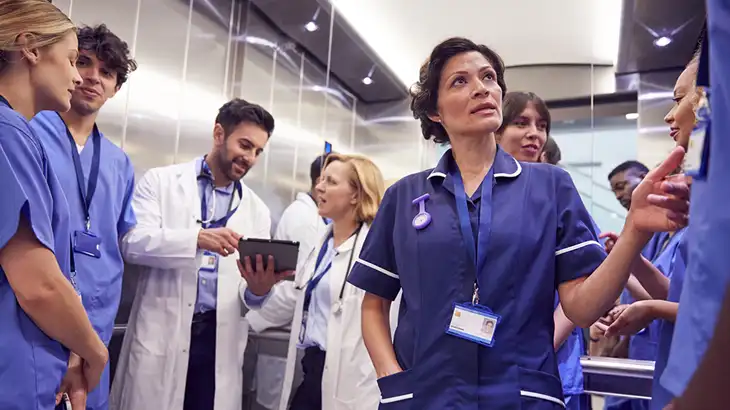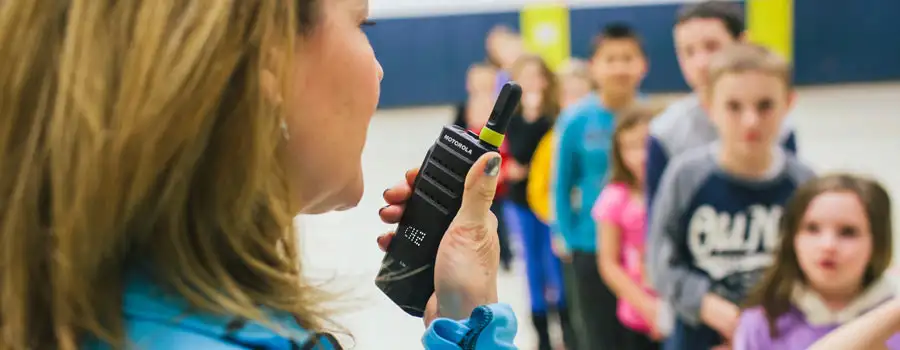Tragic shootings at places like Robb Elementary in Uvalde, TX; Covenant School in Nashville, TN; and St. Francis Hospital in Tulsa, OK have presented a sobering reality: unfortunately, no public space is immune to violence. From schools to hospitals and government buildings, staff are now expected to be more than educators, caregivers, or administrators—they’re also the first line of defense in an emergency.
As a result, many of these institutions regularly participate in active shooter and emergency response drills. These rehearsals prepare staff for worst-case scenarios and also emphasize the importance of acting quickly and as a team. According to the Rockefeller Institute of Government, lockdowns can significantly reduce casualties during a crisis. When considering fatalities only, they report that lockdowns lead to 79% fewer fatalities on the scene and 63% fewer deaths overall.
But a lockdown is only as effective as the communication behind it.
Relying on emails or cell phones in these situations isn’t going to cut it. Two-way radios, on the other hand, provide a fast way to communicate with your team members when a crisis happens. With one-touch communication, secure channels, and instant connectivity, radios give administrators, security teams, and first responders the ability to act decisively—and potentially save lives.
What is a Soft Lockdown?
If you are the parent of a child in primary school, or you are a hospital or government worker, you have likely been introduced to the concept of soft lockdowns in recent years. In past decades, even as recently as the Columbine shooting back in 1999, the chances were that you may have never heard of such a thing. But today, it is our harsh reality.
A soft lockdown is a precautionary security measure used when there is a potential threat outside of a facility—but no immediate danger inside. Unlike a hard lockdown, which is triggered by an active shooter or a direct, internal threat, a soft lockdown allows daily operations to continue with caution. Schools keep teaching. Clinics keep treating. Government offices stay open. But with one major change: the building’s perimeter is sealed.
Typical reasons for initiating a soft lockdown include police activity near the property, a suspicious person spotted outside, or nearby environmental hazards such as fires or gas leaks. During a soft lockdown, exterior doors are locked, visitors are turned away, and staff are placed on heightened alert. While things may appear calm to the public, those inside are prepared to escalate their response if the situation changes.
Who Uses Soft Lockdowns and Why?
Soft lockdowns are most often used in schools, hospitals and medical centers, and government facilities—settings that serve the public and house large groups of people throughout the day. What these spaces have in common is the need to respond quickly to outside threats while keeping operations as normal as possible. Here’s how soft lockdowns function in each of these environments:
Schools
In K–12 schools and college campuses, student safety is the top concern. A soft lockdown gives administrators time to assess a nearby threat while keeping students in classrooms and maintaining a calm environment.
Why it matters:
- Keeps exterior threats from entering
- Allows teaching to continue uninterrupted
- Helps prevent panic among students and staff
Hospitals and Medical Centers
Medical facilities can’t afford to pause critical care, even during a security concern. A soft lockdown helps support hospital safety by locking exterior doors, restricting access, and allowing staff to stay vigilant—all while continuing to care for patients inside.
Why it matters:
- Strengthens hospital safety protocols during external threats
- Protects patients, staff, and visitors without causing panic
- Maintains clinical operations with minimal disruption
- Supports real-time communication with emergency services
Government Facilities
Courthouses, public offices, and municipal buildings are often open to the public, which creates unique challenges during a security concern. A soft lockdown secures entry points without halting essential services.
Why it matters:
- Limits access while continuing operations
- Protects employees and the public
- Provides time to coordinate with law enforcement if needed
Each of these facilities benefits from a soft lockdown’s ability to create a protective barrier without shutting down entirely—provided communication is fast, clear, and well-coordinated.

The Role of Communication During a Soft Lockdown
Without a reliable communication method, soft lockdowns can quickly unravel—and if that potential threat outside becomes an active shooter inside, every second counts. When staff and responders don’t have a clear, unified way to share information, confusion spreads faster than a warning ever could.
Let’s be honest: no one checks their email in a crisis. If you hear gunshots or get word of a dangerous individual nearby, your priority won’t be typing up a message or scrolling through a group thread. You’ll be trying to stay safe, help others, and make fast decisions. Phone calls? They’re too slow, easily missed, and they only reach one person at a time. Not to mention the chaos and background noise that can make it hard to hear or speak clearly.
That’s why instant communication matters. With two-way radios, one push of a button lets you reach your team immediately—no dialing, no waiting. They also support group communication, so everyone gets the same message at the same time, reducing the chance for misunderstandings. Most importantly, they deliver clear, audible updates in real time, keeping everyone focused and informed when it matters most. In a soft lockdown, that level of coordination isn’t just helpful—it’s necessary.
How Two-Way Radios Support Soft Lockdowns
Now let’s get more specific about how two-way radios can help support you and your team in the event of a soft lockdown. These aren’t just tools for security staff—they’re critical communication lifelines that allow quick coordination, real-time updates, and efficient collaboration across entire facilities.
Here’s how they work.
Immediate Communication
In a tense moment, time matters. Two-way radios offer one-button access for staff to send or receive updates without delays or complicated dialing. Whether it’s notifying the front desk to lock the main entrance or alerting campus security about suspicious activity, radios eliminate hesitation.
- Provide instant coordination between administrators, nurses, or teachers and security personnel
- Help reduce confusion by making sure all departments are on the same page
Reliable Signal When Cell Networks Are Jammed
In emergencies, it’s common for cell networks to become overloaded—especially in large buildings or densely populated areas.
- Two-way radios function independently of public cellular networks, so they’re not affected by traffic spikes
- They maintain communication lines even when mobile phones fail
Group Calls for Unified Response
Rather than calling individuals one at a time, radios allow broadcast messaging, ensuring that every key player hears the same message at the same time.
- Coordinate instructions with multiple teams—teachers, nurses, security, custodial staff—simultaneously
- Keep everyone informed and reduce response time
Integration with Emergency Notification Systems
Radios can be integrated with existing security infrastructure, including PA systems, alarms, and dispatch centers.
- Allows for a layered response approach and fast communication with first responders
- Supports faster lockdown execution and status updates during evolving events
But what about the risk of someone hearing the messages—like an active shooter?
That’s a fair concern. But during a soft lockdown, the threat is presumed to be outside the building, not within. These procedures aim to keep that person out. And even if a situation escalates, many commercial buildings are made of dense materials that interfere with signal transmission. Walls, insulation, and complex layouts can significantly hinder radio interception—especially if secure channels are used.
Best Practices for Communication During a Soft Lockdown
At EMCI Wireless in Florida, we are often asked to help businesses create procedures for small lockdowns. And though our specialty is in two-way radios, we do have a few pointers to share when it comes to communication:
- Establish a clear chain of command: Know who initiates the lockdown and who communicates next steps.
- Assign radio channels by role or department: This reduces clutter and keeps critical messages from getting lost.
- Practice messaging during drills: Keep language brief, direct, and consistent.
- Label and store radios in easily accessible areas: Delays in retrieving devices can cost precious time.
- Train every team member: From office staff to custodians, everyone should know how to use a radio in an emergency.
The Difference Between Being Prepared and Being Reactive
Ultimately, the goal of a soft lockdown is to help those inside prepare for what might happen—and to give law enforcement time to address a threat before it becomes imminent. The difference between being prepared and being reactive comes down to one thing: planning.
Prepared organizations don’t wait for chaos to unfold. They establish clear communication procedures, assign responsibilities, and practice their responses regularly. This reduces panic and makes action feel automatic rather than frantic.
Two-way radios play a major role in that preparation. In the middle of uncertainty, they turn potential confusion into real-time coordination. One message can be shared with many. Instructions can be given immediately. And everyone can stay connected without delay.
Protecting What Matters Most Starts with Reliable Communication
Soft lockdowns give schools, hospitals, and government buildings the ability to act quickly and stay in control when a threat looms nearby. But without a solid communication plan, even the best protocols can fall apart. Two-way radios offer the instant, reliable connection needed to coordinate staff, alert responders, and keep everyone safe.
If you’re a decision-maker, now is the time to review your emergency response setup. EMCI Wireless proudly serves all of central and southern Florida—including communities like Hialeah, Leesburg, Ocala, Winter Haven, and beyond. Our team can help you choose the right radio system and build a plan that works in real-life situations. Want to improve safety at your facility? Talk to our team about custom Motorola radio solutions.






